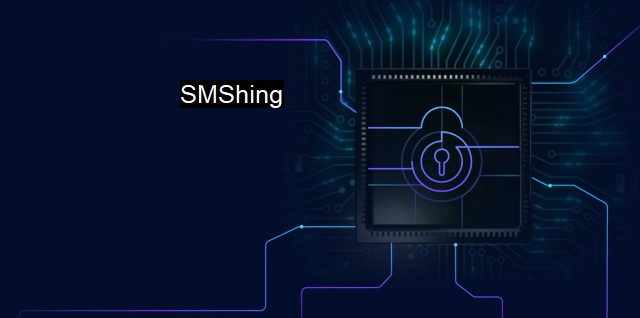What is SMShing?
The Stealthy Threat: Understanding and Avoiding SMShing Attacks in Today's Mobile-Driven World
"Smishing," an amalgamation of the terms SMS and phishing, is a type of fraudulent activity that is widely prevalent in the world of cybersecurity. Taking its name from the Short Message Service provided by mobile phone networks, smishing operates through deceptive text messages in a manner eerily similar to the deceptive emails notorious in phishing attacks—hence the name.A smishing attack usually lures the victim into a scam by provoking fear, curiosity, or a sense of urgency. These attacks contain a call to action for the victim, often in the form of a link that leads to a malicious website or a phone number connected to a fraudulent call center. Like phishing attacks, they try to deceive users into revealing information that should stay confidential, such as passwords, bank account numbers, and credit card information.
These attacks play on a wide variety of sentiments. For instance, you might receive a message informing you of a promotional offer or lottery win to generate excitement. On the flip side, these attacks could use scare tactics instead, bombarding you with messages about a problem with your bank account or a fine that needs immediate attention. Genuine-sounding prompts to "ensure your account's safety" or "claim your prize" then coax you into revealing sensitive data.
Smishing comes with an added danger laden in report-of-fraud SMS and two-factor authentication messages. Cybercriminals all too frequently disguise themselves as prominent banks, popular retail outlets, or even well-known governmental agencies. Acquiring a form of credibility through their abuse of these familiar names, they instill in their victims the pressing need to click on the link provided or call the given number, causing direct communication with the scammers or unsafe downloads onto one’s device.
Smishing can often seem nearly indistinguishable from official messages sent by actual establishments, but there are still effective ways to identify and combat it. The treatment of any unexpected SMS with suspicion, particularly those that request immediate action or contain links to unfamiliar websites, is a prudent first step. Many organizations advise customers to refrain from responding to suspicious texts and instead call official hotline numbers for queries or concerns.
Another effective safety measure against smishing is to avoid sharing personal data through text messages or over the phone, especially to an unverified source. If a text urges you to reveal sensitive information immediately or prompts you to click on a strange link, it is advisable not to respond, as reputable organizations typically do not demand sensitive data unexpectedly.
For companies, implementing quality antivirus software and advanced security systems that cover mobile and other remote devices, can detect malwares and neutralize threats promptly before siphoning off crucial business or customer data. Engaging employees in regularly updated security awareness training can further better their ability to identify potentially malicious emails or text messages and avoid possible smishing traps. Teaching them to never supply unsolicited callers with personal information, and demanding verification before proceeding also fortifies defense.
To summarize, “smishing” is a deceptive form of cyberattack that primarily engages through SMS texts to defraud victims of confidential information. While it holds dangerous potential, cautious use of SMS communications, quality cybersecurity measures, and an educated awareness of phishing schemes can help individuals and businesses navigate safely around these lurking hazards. Remember, prevention is always better than cure, especially in terms of cybersecurity. Stay vigilant and aware to keep your sensitive data secure against smishing threats.

SMShing FAQs
What is smishing?
Smishing is a type of cyber attack that involves sending text messages containing malicious links or attachments. The goal is to trick the recipient into clicking on the link or downloading the attachment, which can infect their device with malware or steal sensitive information.How can I protect myself from smishing attacks?
To protect yourself from smishing attacks, you should follow some basic cybersecurity practices like not clicking on links or downloading attachments from unknown sources, verifying the sender's identity before responding to any text message, and installing antivirus software on your device.What are some common signs of a smishing attack?
Some common signs of a smishing attack include receiving unsolicited or unexpected text messages, messages that urge you to click on a link or download an attachment, messages that ask for personal or sensitive information, and messages that contain spelling or grammatical errors.What should I do if I fall victim to a smishing attack?
If you believe you have fallen victim to a smishing attack, you should immediately stop any further interaction with the attacker, notify your employer, bank or any relevant parties, and take steps to secure your device by running a malware scan, changing your passwords, and monitoring your financial accounts for unauthorized transactions.| | A | | | B | | | C | | | D | | | E | | | F | | | G | | | H | | | I | | | J | | | K | | | L | | | M | |
| | N | | | O | | | P | | | Q | | | R | | | S | | | T | | | U | | | V | | | W | | | X | | | Y | | | Z | |
| | 1 | | | 2 | | | 3 | | | 4 | | | 7 | | | 8 | | |||||||